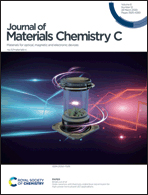A highly sensitive, stable, scalable pressure sensor based on a facile baking-inspired foaming process for a human–computer interface†
Abstract
Flexible and wearable pressure sensors, which can detect various pressures generated by the human body and convert them into electrical signals, are of great interest because they have a wide variety of applications for an interface between humans and external devices. Elastomeric dielectric materials for commercial piezocapacitive pressure sensors need to be manufactured quickly and easily via cost-effective methods. Herein, we report a piezocapacitive pressure sensor based on a three-dimensional macroporous dielectric layer fabricated by a rapid and facile baking-inspired foaming process. The pressure sensor showed high sensitivities of 0.16 ± 0.03 kPa−1 (at <1 kPa) and 0.14 ± 0.02 kPa−1 (at 1–10 kPa) and a low detection limit of 9.8 Pa. Furthermore, 10 000 repetitive compressing and releasing cycles confirmed its reliability. We established that the pressure sensor could move virtual fingers by detecting finger gripping pressure in real time. The respiration rate was also detected by the pressure sensor. A large-scale pressure sensor array was constructed to demonstrate a scaled-up fabrication process. The array accurately recognized spatially distributed pressures generated by objects.



 Please wait while we load your content...
Please wait while we load your content...